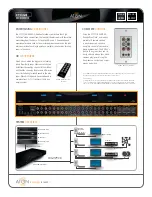Reviews:
No comments
Related manuals for AP140R-E1

AX Series
Brand: A10 Networks Pages: 17

G-DRIVE ev ATC
Brand: G-Technology Pages: 35

Sun Fire X2100 M2
Brand: Sun Microsystems Pages: 128

4-Port USB 2.0 Device Server over IP...
Brand: Quatech Pages: 2

Ultra Enterprise 3000
Brand: Sun Microsystems Pages: 48

ftServer 2500
Brand: Stratus Pages: 106

ReadyNAS Duo
Brand: Infrant Technologies Pages: 98

N3200PRO
Brand: Thecus Pages: 102

ExtremeControl IA-A-305
Brand: Extreme Networks Pages: 31

EC8200A01-E6
Brand: Extreme Networks Pages: 94

PowerEdge R6415
Brand: Dell EMC Pages: 139

t100
Brand: Atrust Pages: 21

HDR44
Brand: ATON Pages: 2

ABLELink SW2001
Brand: Atop Pages: 51

ABLELink GW21 MAXI Series
Brand: Atop Pages: 110

9000 APPLIANCE SERIES
Brand: Arcserve Pages: 14

AS7110T
Brand: ASUSTOR Pages: 11

Delta
Brand: 7thSense Pages: 44

















